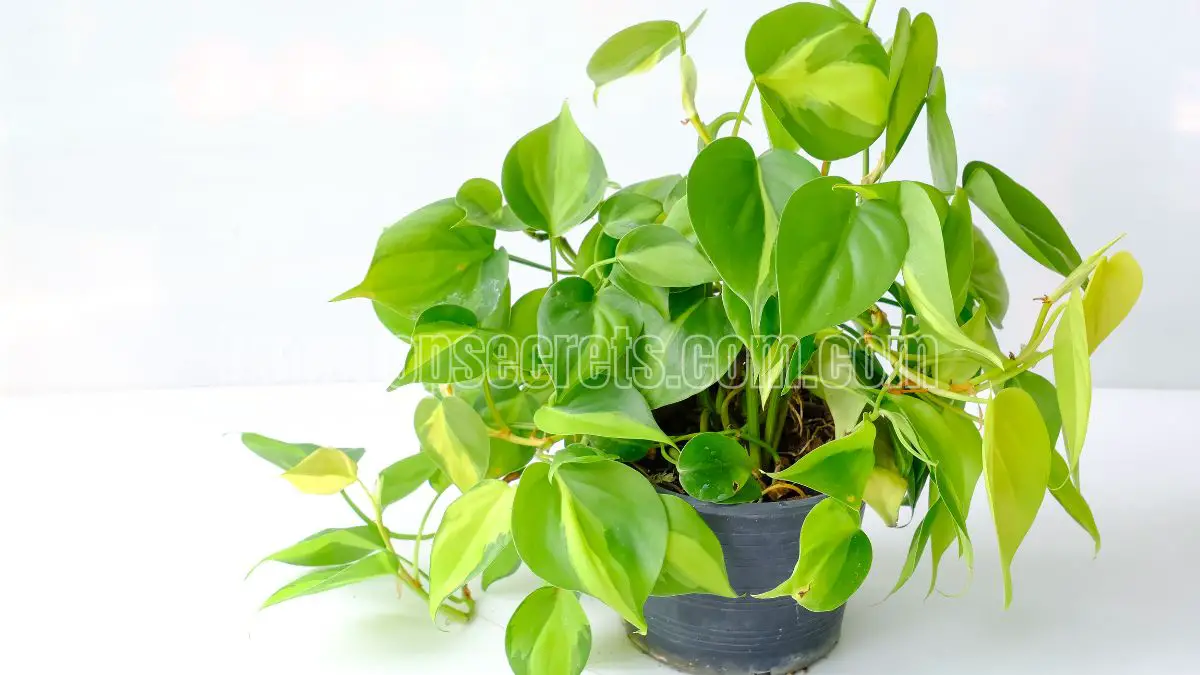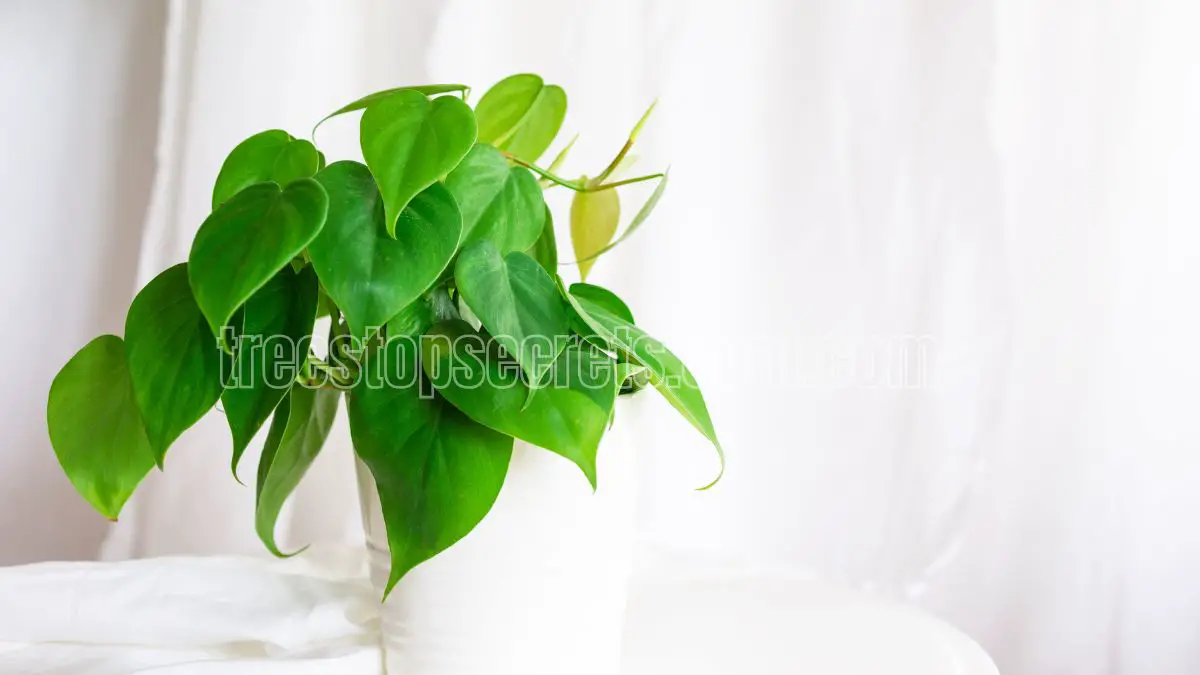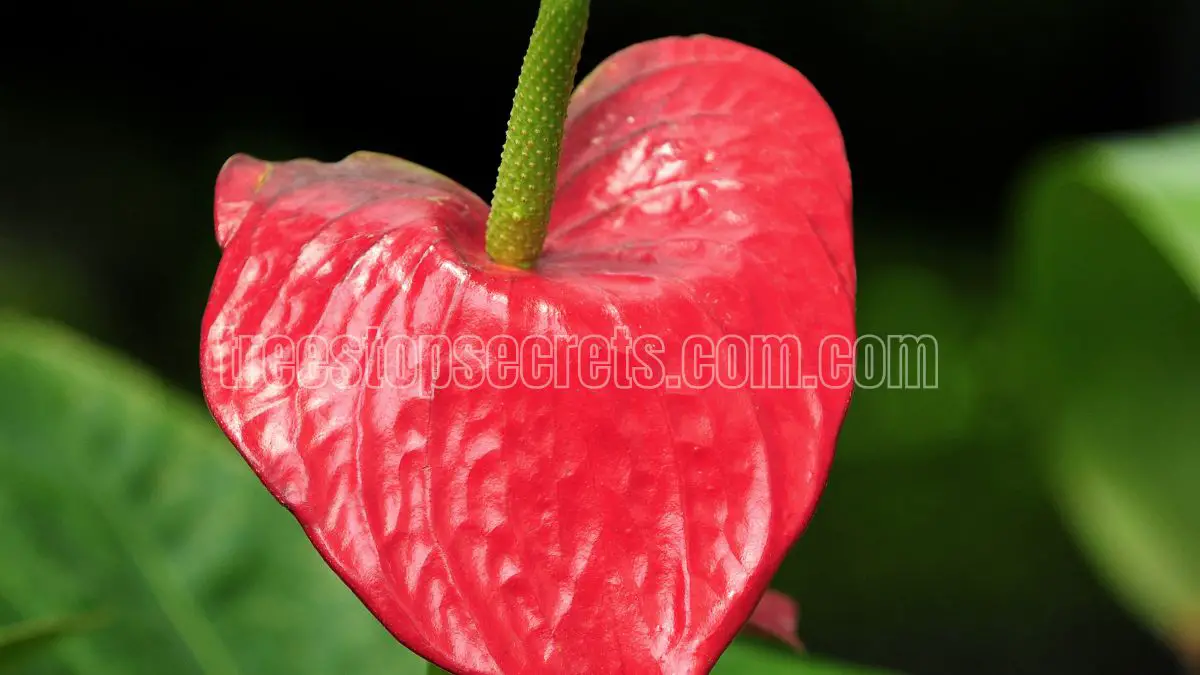With the right care, especially in terms of light, water, and humidity, you can enjoy this beautiful pink princess philodendron for years to come. This houseplant superstar is known for its bright pink and green foliage.
As a plant that does well in bright, indirect sunlight, it’s perfect for lots of areas of the home. Consistent watering is important, making sure to keep the soil evenly moist, never saturated.
Keep humidity levels up. These plants love a humid environment, which is just what they’re used to in their homelands. Learning these simple care needs will go a long way towards keeping your pink princess philodendron looking its best with bright pink variegations and a robust appearance.
In the subsequent sections, we’ll dive into specific care advice to help your Pink Princess thrive in your living space.
Key Takeaways
- The pink princess philodendron never fails to impress with its beautiful pink variegation and gorgeous heart-shaped leaves. This beauty has quickly become the darling of houseplant collectors here in Los Angeles.
- Provide your plant with bright, indirect light to keep it colorful and vivid. Use sheer curtains to soften strong sunlight.
- Water your pink princess infrequently, only when the top inch of soil is dry. Monitor it regularly for any symptoms of over or underwatering to keep it thriving.
- Providing a humidity level of 50-60% and a temperature range of 65°F to 80°F will help keep your Pink Princess looking its best and growing vibrantly.
- Plant in a loose, well-draining soil mix for best results. Blend peat moss, perlite, and orchid bark together so your plant gets the nutrients it needs without the risk of root rot.
- Fertilize actively during the growing season with a balanced liquid fertilizer. During the winter months, reduce feeding to allow the plant to settle into its natural dormancy.
Overview of Pink Princess Philodendrons

Unlike other philodendron varieties, the pink princess philodendron is known for its rare pink variegation, which makes it special. This stunning plant features bronze-green leaves adorned with streaks and splashes of pink, creating an eye-catching display that appeals to both casual plant lovers and collectors alike.
As a vining plant with beautiful heart-shaped leaves, this beauty has gained immense popularity in houseplant collections around the world.
1. What Makes Pink Princess Unique?
The pink princess’s impressive coloration comes from a genetic mutation that significantly affects its variegation. Different from regular philodendrons, this variety shows off a stunning combination of green and pink, creating a striking look that’s hard to find.
This rarity is what makes it so desirable for collectors. Because of this, prices range widely anywhere from $30 for smaller plants up to $2,000 for larger, well-rooted specimens. Its stunning aesthetic can enhance interior environments, bringing an air of sophistication fused with exotic artistry.
2. Characteristics of Pink Princess Philodendrons
Fully grown pink princess philodendrons can grow about 4 to 5 feet tall and 2 to 3 feet wide. They’re stunning houseplants that can be excellent additions to any houseplant collection!
Their waxy, leathery leaves are the definition of evergreen, giving you yearlong aesthetic pleasure. For optimal growth, they require a potting mix comprising one part standard potting soil, one part perlite, and one part orchid bark.
Pink Princess philodendrons do best in bright, indirect light, around 6-8 hours per day, and enjoy temperatures ranging from 65°F to 79°F. In too little light, the pink tones may gradually disappear.
Light Requirements for Pink Princess
To keep your coveted Pink Princess Philodendron vibrant and healthy, provide it with enough sunlight. Understanding these lighting requirements is essential for maintaining your princesses' pink variegation and ensuring vigorous growth in the plant world.
1. Ideal Light Conditions for Vibrant Color
In general, this plant needs bright, indirect light of at least 6-8 hours per day. Placing it by a window that has sheer curtains will do the trick. Sheer curtains are perfect for softening the direct rays without depriving your Pink Princess of necessary light.
If you live in a space with little natural sunlight, particularly in the wintertime, look into getting a grow light. Position it 12-24 inches above the plant to provide the equivalent of about 12 hours of sunlight a day to supplement its needs.
Using a timer to keep a regular light schedule will mimic the cycle of daylight in nature, providing balance and calm.
2. Signs of Insufficient or Excessive Light
Identifying the symptoms of light stress is the key. Insufficient light leads to leggy growth as the plant reaches towards the nearest light source. This insufficient light can cause the pink leaves to lose their beautiful pink coloration.
On the opposite end of the spectrum, too much light will result in burned leaf edges and yellowing. Whenever possible, place your Pink Princess a few feet back from windows that receive direct sunlight during the hottest parts of the day.
This will further prevent damage by direct, harsh indoor sun. Using hanging grow lights 12–18 inches above the plant can give adequate light without scorching the foliage.
Watering Guidelines for Pink Princess
Proper care for a Pink Princess Philodendron starts with understanding its watering requirements. These needs are not static, but rather dynamic as they depend on the season and weather patterns. Creating a consistent watering routine with your Pink Princess will help her thrive!
Pink Princess is particularly susceptible to fluctuations in moisture, so regular attention is key.
1. How to Determine Watering Frequency
The finger test is an easy, practical way to tell when your Pink Princess needs water. Watering with your finger guidelines: Insert your finger into the soil all the way to the second knuckle. The soil at the top 1-2 inches should be dry when it’s time to water.
Especially during the summer months, you may need to water about once a week. Soil shouldn’t be a guessing game. It’s better to wait an extra day than it is to overwater.
Taking note of how your plant looks can be another helpful indicator as well. Healthy leaves that are firm and vibrant signify adequate moisture, while wilting or drooping can indicate a need for water or adjustments in frequency.
2. Effects of Overwatering and Underwatering
Overwatering is the most common mistake when watering a plant, which can cause root rot and mushy leaves. When the soil is overly wet for extended periods, roots may drown, resulting in plant death.
Underwatering shows up as droopiness and crispy leaf edges, indicating that your plant isn’t getting enough water. When you allow the soil to dry out between watering, the Pink Princess will flourish.
Aim for it to feel roughly 75% dried out before you water once more. A simple soil test is the best way to know if your Pink Princess is thirsty, particularly when it’s dry at least two inches deep.
Humidity and Temperature Needs
The pink princess philodendron, a coveted plant among plant collectors, prefers high levels of humidity and moderate temperatures, both of which greatly influence its growth and health. Understanding pink princess philodendron care will set you up for success in cultivating vibrant leaves.
1. Optimal Humidity Levels for Growth
For the pink princess, 60%-80% humidity is perfect. To do this, consider placing a humidifier close to the plant. Or, set the plant on a pebble tray that’s had water added.
This requires an atmosphere with a lot of moisture and a very stable environment. Frequent misting of the leaves will aid in keeping the humidity up. Misting your plants lightly several times a week will prevent your plant’s leaves from drying out.
This is critical in drier indoor environments.
2. Temperature Ranges for Healthy Plants
Temperature is just as important when growing the pink princess. Their ideal temperature range is 65°F to 80°F. Maintaining the plant around these temperatures encourages lush growth and colorful leaves.
Keep the plant away from cold drafts and sudden temperature changes. Appropriately managed, these conditions can stress the plant and shape its development.
Be sure to protect your plant from windows that could become excessively cold at night. Furthermore, don’t put it next to heating vents so that environmental conditions don’t vary too much.
Soil Preferences for Pink Princess
When taking care of a pink princess philodendron, often considered one of the most coveted plants among plant collectors, the proper soil is key to maintaining vibrant leaves. Choosing the right potting mix formulated for aroids aids in drainage and moisture retention, making a world of difference in ensuring your pink princess thrives with enough sunlight and care.
1. Best Soil Mix for Drainage and Nutrients
To ensure proper drainage and nutrient content, a combination of peat moss, perlite, and orchid bark would be ideal. This mix provides great drainage without leaving the plant open to root rot while still retaining moisture.
The peat moss helps with moisture retention and the perlite adds aeration. Orchid bark contributes structure and improves drainage even more. Adding organic matter—like compost—helps improve drainage and nutrient content.
This will provide your plant with the key nutrients that it requires in order for it to flourish.
2. Importance of Soil pH for Philodendrons
Creating proper soil pH is essential for the pink princess. The sweet spot is somewhere in the middle, between 5.5 and 6.5.
This low but acidic environment of the soil allows for optimal nutrient absorption. When the pH falls outside of this range, the plant is unable to take up nutrients properly.
This can cause deficiencies and inhibit its growth. Make sure to check your soil’s pH regularly.
This helps you add what you need to, such as lime to increase pH or sulfur to decrease it, helping your philodendron thrive and bring vibrancy to your space.
Fertilizer Recommendations for Growth

Fertilizing your pink princess philodendron with the appropriate nutrients will help encourage vibrant leaves and robust growth. Properly choosing fertilizer and timing your applications will go a long way in helping this coveted plant look its best.
1. Types of Fertilizers Suitable for Pink Princess
A balanced liquid houseplant fertilizer is best for routine feeding. Choose a balanced formula with all three nutrients in equal parts, like a 20-20-20 fertilizer. This will help to ensure that your new plant is receiving the nutrients it needs to promote healthy leaf growth and robust root establishment.
Organic alternatives such as compost tea or worm castings can provide healthful nutrients naturally. These options benefit your plant with essential nutrients while building healthy soil in the long run, resulting in robust plant life.
2. Frequency and Timing of Fertilization
Fertilization frequency & timing is important. Fertilize your pink princess at 4–6 week intervals throughout the growing season. Since this often occurs during spring and summertime, ensure you’re keeping your grass well-fed!
Such frequent application encourages vigorous top growth, which helps the tree absorb these nutrients through foliar uptake. On the flip side, it’s key to cut back or eliminate fertilization during the winter’s dormant season.
This period of dormancy helps the plant save energy and get ready for fresh new growth come warmer weather.
Common Care Issues and Solutions
Caring for a pink princess philodendron can be incredibly enjoyable, especially for plant collectors who admire its vibrant leaves and coveted pink color. However, there are several common issues, such as rust spots and diseases, that can arise. By understanding these problems, owners can ensure their tropical plants receive enough sunlight and proper pink princess philodendron care to thrive.
To avoid these issues, it’s essential to repot your plant when necessary and provide enough light. Engaging with communities on platforms like Facebook Marketplace and Etsy can also help you connect with fellow gardening enthusiasts, like Phoebe Cheong, who share expertise and tips on maintaining these beautiful princesses.
1. Addressing Leaf Discoloration and Variegation Loss
The first and most obvious common care concern is leaf discoloration, often revealing poor lighting conditions. When these leaves begin to lose their brilliant pink colors, it might be time to change their location.
Relocating the plant to an area with filtered, bright light may return the plant’s color. Check underneath the leaves for signs of pests or disease.
Aphids or spider mites can easily suck the life out of your plant, causing leaf discoloration and variegation loss. Insecticidal soap or neem oil is a very effective treatment for getting rid of these little buggers.
2. Managing Leggy Growth and Brown Spots
Leggy growth, which is when plants grow long stems with few or no leaves on them, is a common bane of indoor gardeners. This is usually due to lack of light.
To promote a bushier habit, regular pruning is important. Cut back those long, leggy stems to make way for fresh new growth and bushier foliage.
Additionally, providing the appropriate amount of light is another key factor. A spot with bright, indirect light will avoid browning due to sunburn or lack of moisture.
Monitor the soil moisture closely to prevent root rot. Keep in mind, root rot does create brown spots on swimmy too.
By implementing these preventive steps, you can go a long way to keeping your pink princess philodendron thriving and beautiful.
Propagation Methods for Pink Princess
Whether taking cuttings to grow new plants or eventually increasing your collection while keeping your plants healthy, propagation is an effective method to use. This section will explore effective methods for propagating this striking variety, emphasizing both the techniques and the benefits of propagation.
1. Techniques for Successful Stem Cuttings
One of the easiest ways to propagate pink princess philodendrons is with stem cuttings. Start by choosing a strong stem from an established plant with two or more leaves. With clean, sharp scissors or pruning shears, snip the stem a few inches below a node.
This node is important for rooting. Put it in water or in a fast-draining potting mix with the node submerged or covered. If you’re rooting cuttings in water, be sure to change the water frequently to keep it fresh. After 2-4 weeks, you’ll usually see roots begin to form.
Working with clean tools is extremely important. This stops the spreading of pathogens that can kill your plants. It’s a good idea to use rooting hormone when propagating cuttings to encourage strong root growth.
Once you’ve got some roots, you can transplant your cutting into a pot with appropriate potting soil.
2. Air Layering as a Propagation Method
Air layering is a great alternative propagation method, particularly for mature pink princess philodendrons. This technique allows you to develop a new root system while the cutting is still connected to the mother plant.
First, find one healthy branch and make a small upward cut halfway through the stem. Cover the cut area with damp sphagnum moss and wrap it in plastic wrap to help keep the humidity. Use tape or string to secure the wrap in place.
After a few weeks, you will notice roots starting to develop within the moss. After it has rooted, cut the cutting from its parent plant and pot it in a suitable potting mix.
This is a really great method since it helps larger, more well-established plants to be propagated.
Pruning Tips for Pink Princess
Pruning is key to keeping your Pink Princess Philodendron healthy and beautiful. Routine pruning maintains the natural shape of this coveted plant and encourages good growth, ensuring enough sunlight reaches its vibrant leaves for optimal pink color.
1. When and How to Prune for Aesthetic Appeal
Be prepared to prune continually throughout the growing season, usually starting in spring or early summer. This timing will give the plant time to bounce back quickly and encourage strong fresh growth.
Better yet, if you’re looking for aesthetics, cut back the long, leggy stems to promote a fuller, bushier appearance. If you ever do spot a stem making a run for the light, cut it down. This will promote the development of side shoots and help to form a fuller, more symmetrical look.
2. Encouraging Bushier Growth Through Pruning
To encourage bushier growth through pruning, prune at specific nodes. These nodes are the points from which leaves grow, and pruning just above them promotes new growth.
If you prune above a node with two leaves on a stem, you will be able to promote the development of two new branches. This will help produce a fuller and bushier plant.
This is important not just for aesthetics but for the health of your plant. This practice eliminates disease and enables the plant to focus its energy on producing new growth.
Conclusion
Caring for your pink princess philodendron doesn’t have to be complicated or overwhelming. Give it the proper lighting, watering, and humidity level for your pink princess philodendron to really thrive. Make sure to provide it with attractive, well-draining soil and feed it regularly with the proper type of fertilizer. Keep an eye out for issues like infestations or leaf yellowing. Make sure you’re taking these steps to ensure your plant stays happy and healthy! If you’re looking to grow your collection or give a few to friends, use propagation!
Frequently Asked Questions
What is a Pink Princess Philodendron?
What is a Pink Princess Philodendron? The Pink Princess Philodendron is one of the most coveted tropical plants, known for its vibrant leaves that pop with pink color. This is why it’s a favorite for indoor gardens, especially with its stunning appearance and fairly simple pink princess philodendron care.
How much light does a Pink Princess need?
Pink Princess Philodendrons thrive indoors in bright, indirect light, as this vibrant plant's growth is optimal when positioned near a window. Too much direct sunlight can lead to issues like leaf burn.
How often should I water my Pink Princess?
Generally, you should water your Pink Princess Philodendron when the top inch of soil has dried out, which usually ends up being every 1-2 weeks. However, this frequency may vary based on how humid or warm your tropical plants are indoors.
What humidity level is best for Pink Princess Philodendrons?
These tropical plants thrive in humid environments with humidity levels of at least 50-70%. For plant collectors, especially those interested in pink princess philodendron care, adding a humidifier can help. Alternatively, set a tray of water next to your plant to slowly rehydrate the air around it.
What type of soil is best for Pink Princess Philodendrons?
To ensure optimal pink princess philodendron care, provide a well-draining potting mix, preferably one designed for aroids, using a mixture of potting soil, perlite, and orchid bark for vibrant leaves.
Should I fertilize my Pink Princess Philodendron?
Yes, you should fertilize your Pink Princess Philodendron during the growing season (spring and summer) with a balanced liquid fertilizer, every 4-6 weeks. This promotes bushy growth and colorful variegated leaves.
How can I propagate my Pink Princess Philodendron?
You can propagate through stem cuttings that have a minimum of one node. Put the cuttings in water or damp potting mix and keep them in bright, indirect light until roots form.
Image Source: Paid image from CANVA




